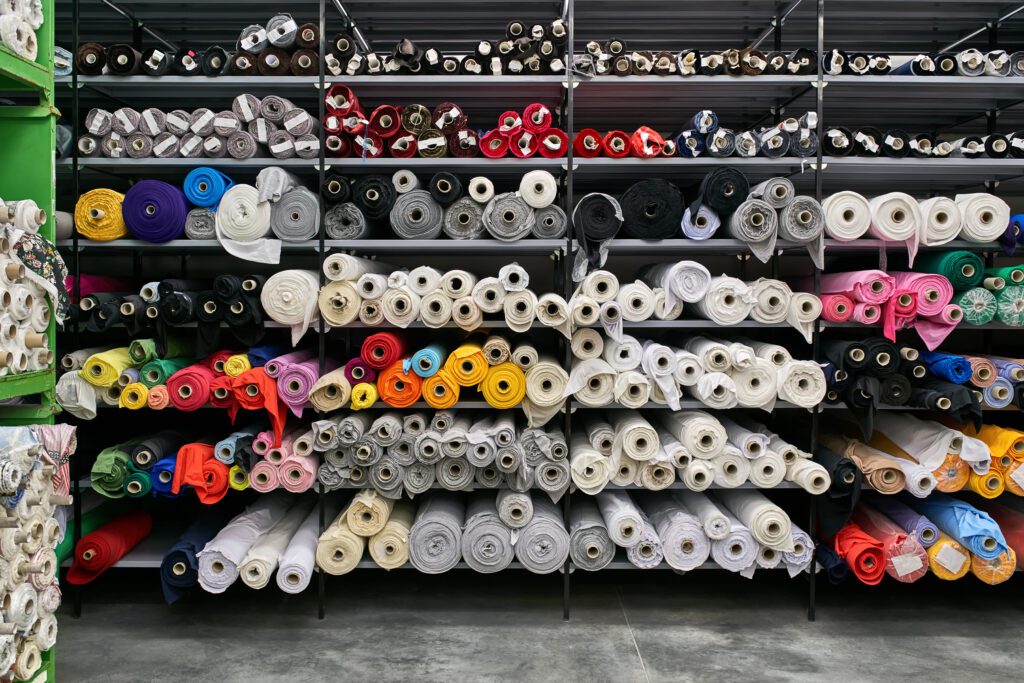
While using deadstock is a modern approach to conscious fashion, some designers can be skeptical about it. The most common concerns are ensuring quality, occasional overpricing, and limited availability. In this blog post, we answer the most popular questions about deadstock and share how apparel brands, especially small ones, can benefit from using these fabrics.
1. What is deadstock fabric?

Deadstock fabrics are surplus textiles left unused for various reasons, such as overproduction, order cancellations, or discontinued styles. At Pine Crest Fabrics, our deadstock collection comes from stocked excess fabrics, which we offer at a reduced price.
The term “deadstock” became popular in recent decades due to sustainability and textile waste reduction practices. Nowadays, designers use deadstock to craft unique, eco-friendly collections.
2. Is deadstock fabric sustainable?

Using deadstock fabric is an affordable way for brands to embrace sustainability by reducing textile waste. Let’s discover how:
- Giving fabric a new life: Deadstock prevents unused materials from ending in landfills.
- Reducing overproduction: It lowers the demand for newly manufactured textiles, decreasing resource waste.
- Saving water and energy: No additional resources are needed for new production since the fabric is already produced.
By choosing deadstock, designers can support a circular economy and be eco-conscious while maintaining the high-quality garments they produce.
3. Where and how can I buy deadstock fabric?
The easiest way is to contact your fabric supplier. For example, Pine Crest Fabrics offers a large deadstock collection with high-quality excess fabrics for activewear, swimwear, costumes, and more. You can shop these fabrics at a reduced price of up to 50% off.
Remember that deadstock collections are limited, and the best fabrics sell quickly. We recommend searching for deadstock collections on the supplier’s website or asking your fabric specialist.
You can also find deadstock fabric from large apparel brands. The collection will be limited and seasonal.
4. How can I ensure the quality of deadstock fabrics?

Some designers are skeptical about deadstock fabric quality. Here are some tips on how to source high-quality deadstock:
- Choose trusted sources: Buy from deadstock suppliers you trust. Find out how long the company has been on the market and what customers say about their experience. More than 80% of PCF’s deadstock fabrics come from our trusted suppliers.
- Fabric testing: Try fabrics before ordering in bulk. At Pine Crest Fabrics, we conduct in-house testing to ensure weight, stretch, and colorfastness. We can also send you a fabric swatch so you can evaluate it yourself.
- Ask about storage: Properly stored deadstock retains its original condition, making it as good as newly produced fabric.
5. Are deadstock fabrics suitable for small brands?
Deadstock fabrics have significant advantages for small brand designers focusing on sustainability and affordability. They include:
- Cost savings and high quality: Deadstock fabrics are usually sold with discounts, which makes high-quality fabrics more accessible.
- Uniqueness: Limited-run fabrics help create one-of-a-kind designs that stand out.
- Mixing with core fabrics: Use deadstock alongside regularly stocked materials to balance uniqueness with consistency.
- Eco-friendly impact: Choosing deadstock reduces textile waste and supports a circular fashion system.
6. Are deadstock fabrics expensive?
Some premium fabrics from luxury brands can be expensive. However, some suppliers often sell deadstock fabrics at a discounted price. At Pine Crest Fabrics, we offer up to 50% off our deadstock collection, making it an affordable option for designers.
7. How do I work with limited quantities of deadstock fabric?

Working with deadstock requires a flexible design mindset, but it’s a great way to create affordable, sustainable, and unique fashion pieces. Since deadstock comes in various, often limited, amounts, it’s important to plan collections carefully. Here are some tips:
- Make capsule collections. With limited runs, you create a sense of exclusivity and urgency for consumers.
- Combine deadstock with other fabrics to extend its use across different designs.
- Consider accessories, lining, or statement details if you can’t get enough fabric for full garments.
Conclusion
Deadstock fabrics are a great option for apparel designers, especially small brands, looking for affordable and eco-conscious fabric choices for a unique collection that stands out. When sourced from trusted suppliers with sample and testing availability before ordering, deadstock quality is comparable to other fabrics. If you’re not buying deadstock fabrics from luxury brands, you can get premium fabrics at a much lower price. Finally, using deadstock fabrics is a great opportunity for small apparel brands to reduce textile waste and commit to sustainable fashion.
At Pine Crest Fabrics, we make it easy to source high-quality deadstock fabrics at discounted prices. Explore our latest deadstock collection and contact us for details.






